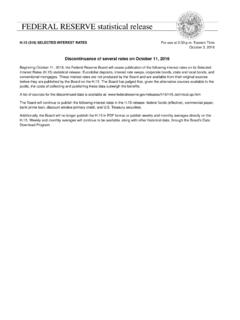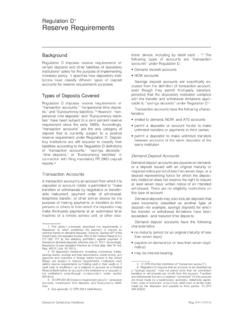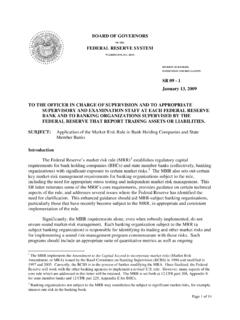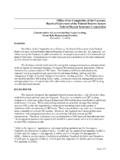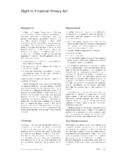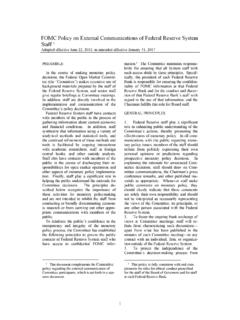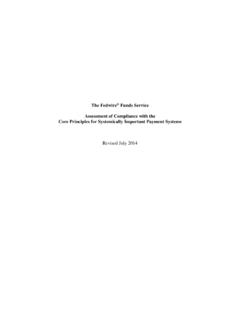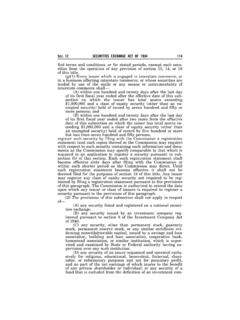Transcription of Regulation X Real Estate Settlement ... - Federal Reserve
1 Regulation XReal Estate Settlement Procedures ActThe real Estate Settlement Procedures Act of 1974(RESPA) (12 2601et seq.) (the act) becameeffective on June 20, 1975. The act requireslenders, mortgage brokers, or servicers of homeloans to provide borrowers with pertinent andtimely disclosures regarding the nature and costsof the real Estate Settlement process. The act alsoprohibits specific practices, such as kickbacks,and places limitations upon the use of escrowaccounts. The Department of Housing and UrbanDevelopment (HUD) originally promulgated Regu-lation X, which implements has amended RESPA significantlysince its enactment.
2 The National Affordable Hous-ing Act of 1990 amended RESPA to requiredetailed disclosures concerning the transfer, sale,or assignment of mortgage servicing. It alsorequires disclosures for mortgage escrow ac-counts at closing and annually thereafter, itemizingthe charges to be paid by the borrower and what ispaid out of the account by the October 1992, Congress amended RESPA tocover subordinate lien , when it enacted the Economic Growthand Regulatory Paperwork Reduction Act of 1996,1further amended RESPA to clarify certain defini-tions including controlled business arrangement, which was changed to affiliated business arrange-ment.
3 The changes also reduced the disclosuresunder the mortgage servicing provisions of 2008, HUD issued a RESPA Reform Rule (73 Fed. Reg. 68204, November 17, 2008) that in-cluded substantive and technical changes to theexisting RESPA regulations and different implemen-tation dates for various provisions. Substantivechanges included a standard Good Faith Estimateform and a revised HUD-1 Settlement Statementthat were required as of January 1, 2010. Technicalchanges, including streamlined mortgage servic-ing disclosure language, elimination of outdatedescrow account provisions, and a provision permit-ting an average charge to be listed on the GoodFaith Estimate and HUD-1 Settlement Statement,took effect on January 16, 2009.
4 In addition, HUDclarified that all disclosures required by RESPA arepermitted to be provided electronically, in accor-dance with the Electronic Signatures in Global andNational Commerce Act (E-Sign).2 The Dodd-Frank Wall Street Reform and Con-sumer Protection Act (Dodd-Frank Act), Pub. (July 10, 2010) granted rulemaking author-ity under RESPA to the Consumer Financial Protec-tion Bureau (CFPB) and, with respect to entitiesunder its jurisdiction, generally granted authority tothe CFPB to supervise for and enforce compliancewith RESPA and its implementing 2011, the CFPB restated HUD s imple-menting Regulation at 12 CFR part 1024 (76 78978) (December 20, 2011).
5 On January 17, 2013, the CFPB issued a finalrule to amend Regulation X (78 Fed. Reg. 10695)(February 14, 2013). The final rule implementedcertain provisions of Title XIV of the Dodd-Frank Actand included substantive and technical changes tothe existing regulations. Substantive changes in-cluded modifying the servicing transfer noticerequirements and implementing new proceduresand notice requirements related to borrowers errorresolution requests and information requests. Theamendments also included new provisions relatedto escrow payments; force-placed insurance; gen-eral servicing policies, procedures, and require-ments; early intervention; continuity of contact; andloss mitigation.
6 The amendments are effective as ofJanuary 10, July 10, 2013, September 13, 2013, andOctober 22, 2014, the CFPB issued final rules tofurther amend Regulation X (78 Fed. Reg. 44685(July 24, 2013), 78 Fed. Reg. 60381 (October 1,2013), and 79 Fed. Reg. 65299 (November 3,2014)). The final rules included substantive andtechnical changes to the existing regulations,including revisions to provisions on the relation tostate law of Regulation X s servicing provisions, tothe loss mitigation procedure requirements, and tothe requirements relating to notices of error andinformation requests.
7 On October 15, 2013, theCFPB issued an interim final rule to further amendRegulation X (78 Fed. Reg. 62993) (October 23,2013) to exempt servicers from the early interven-tion requirements in certain circumstances. TheRegulation X amendments are effective as ofJanuary 10, amendments issued on January 17, 2013;July 10, 2013; September 13, 2013; October 15,2013; and October 22, 2014, are collectivelyreferred to in this document as the 2013-2014 Amendments. On December 31, 2013, the CFPB publishedfinal rules implementing sections 1098(2) and1.
8 Pub. L. 104-208, Div. A., Title II 2103 (c), September 30, 15 7001et Dodd-Frank Act secs. 1002(12)(M), 1024(b)-(c), and 1025(b)-(c); 1053; 12 5481(12)(M), 5514(b)-(c), and 5515(b)-(c).Consumer Compliance HandbookRegulation X RESPA 1 (11/15)1100A(5) of the Dodd-Frank Act, which direct theCFPB to publish a single, integrated disclosure formortgage transactions, which includes mortgagedisclosure requirements under the and Truth inLending Act (TILA) and sections 4 and 5 of amendments are referred to in this docu-ment as the TILA-RESPA Integrated DisclosureRule or TRID, and are applicable to coveredclosed-end mortgage loans for which a creditor ormortgage broker receives an application on or afterOctober 3, a result, Regulation Z nowhouses the integrated forms, timing, and relateddisclosure requirements for most closed-end con-sumer mortgage new integrated disclosures are not used todisclose information about reverse mortgages.
9 Home equity lines of credit (HELOCs), chattel-dwelling loans such as loans secured by a mobilehome or by a dwelling that is not attached to realproperty ( , land), or other transactions notcovered by the TILA-RESPA Integrated Disclosurerule. The final rule also does not apply to loansmade by a creditor who makes five or fewermortgages in a year. Creditors originating thesetypes of mortgages must continue to use, asapplicable, the Good Faith Estimate, HUD-1 Settle-ment Statement, and Truth in Lending A General ProvisionsCoverage 12 CFR (a)RESPA is applicable to all federally relatedmortgage loans, except as provided under 12 CFR (b) and (d), discussed below.
10 Federally related mortgage loans are defined asloans (other than temporary loans), includingrefinancings, that satisfy the following two criteria: First,the loan is secured by a first or subordinatelien on residential real property, located within astate, upon which either a one-to-four family structure is located or is tobe constructed using proceeds of the loan(including individual units of condominiumsand cooperatives); or a manufactured home is located or is to beconstructed using proceeds of the loan. Second,the loan falls within one of the followingcategories: loans made by a lender,5creditor,6dealer;7 loans made or insured by an agency of thefederal government; loans made in connection with a housing orurban development program administered byan agency of the Federal government; loans made and intended to be sold by theoriginating lender or creditor to Federal Na-tional Mortgage Association (FNMA), Govern-ment National Mortgage Association (GNMA),or Federal Home Loan Mortgage Corporation(FHLMC) (or its successor).
